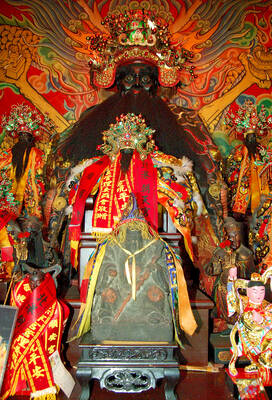In the Kafkaesque world of Chinese political repression, two words stand out as epitomizing continuity and adaptation in the Chinese Communist Party’s (CCP) reliance on incarceration to ensure its survival: lao (勞, labor) and gai (改, reform). Drawing from the Maoist philosophy that work for the betterment of the nation will purify one’s thoughts, the laogai, or “reform through labor,” is a system by which “antisocial” elements are removed from society and “reformed.” Not only are convicts and dissidents detained and “reformed,” but as Laogai: The Machinery of Repression in China shows, the state profits handsomely from the unpaid labor that takes places in those camps.
That system is not only rampant across China, with 909 laogai camps verified by the Laogai Research Foundation, but it is marked with innumerable abuses, including inadequate food and medical care, crowded, unsanitary and oftentimes dangerous work environments and disciplinary cruelty that, in many cases, has left permanent psychological scars on an inmate or resulted in his death.
According to research conducted by the authors, as many as 3 million to 5 million people are currently imprisoned in laogai camps, and between 40 million and 50 million have passed through them since 1949, when the People’s Republic of China (PRC) was born. Other statistics paint a disconcerting picture: Ninety-nine percent of people charged with “endangering state security” in China are found guilty and will likely end up in the laogai system; 500,000 people are believed to be in arbitrary detention across China at any given time; 40 percent of laogai prisoners are sentenced to more than five years of imprisonment, life imprisonment or death.
During the Mao era, convicts — from criminals to political dissidents — swallowed by the laogai system provided unpaid labor for massive infrastructure projects that the PRC simply could not have afforded had it paid for their work. As early as 1954, the Chinese government was stating that “Laogai production must serve the economic construction of the state and be a part of the general plan of production and construction of the state.”
Eventually, as China opened its doors to international trade under Deng Xiaoping’s (鄧小平) guidance, the laogai camp turned into a profitable instrument by which local officials could enrich themselves, by using unpaid labor in the budding factory sector. Throughout the 1990s, laogai enterprises were directly managed by prison officials and expected to meet all the costs of running the camp with the profits from the enterprises. The idea, the authors tell us, was to encourage laogai officials to operate at a profit.
Lax international regulations and weak enforcement of rules, as well as the use of the import-export company system to mask the origin of laogai products, allowed the CCP to get away with “reform through work” for decades. As the book informs us, as many as 314 businesses listed in Dun and Bradstreet databases are clearly linked to laogai camps, which were often situated right next to a factory or use factories as a front (this has now changed somewhat, in that rather than being directly managed by prison officials, laogai enterprises are now physically separated from prisons but are bound by contract). Laogai products documented in the book that have entered our markets include a variety of teas, rubber boots, wrenches, socks, artificial flowers and even sulfuric acid. The more consumers all over the world consume laogai products, the more the Chinese government will continue to profit from the imprisonment and exploitation of prisoners, the book argues. In fact, a case could be made that this could encourage the state to continue imprisoning a large number of Chinese for even minor violations, or for various forms of what the CCP regards as dissent.
Amid the bad publicity engendered by the laogai, Chinese authorities switched from the designation laogai to jianyu (監獄), or prison. But as the book tells us, the new name was not accompanied by a change in policy and served more as a political smokescreen. As the government-sanctioned Beijing Legal Daily wrote in 1995: “Our renaming of the laogai is what our associating with the international community calls for, and it is favorable in our international human rights struggle.
“Henceforth, the word laogai will no longer exist, but the function, character and tasks of our prison administration will remain unchanged.”
They also argue that as prisoners in laojiao (勞教, re-education through labor) camps are under “administrative detention” and therefore not considered convicted criminals under Chinese law, goods produced by inmates do not constitute prison labor goods for the purpose of bilateral agreements reached between China and a number of countries.
Sadly, the book’s title is somewhat misleading, as rather than simply focus on the laogai system, it also contains chapters on the history of human rights (or lack thereof) in China, black prisons, executions, organ harvesting and control of the media. It also adopts what is slowly — and necessarily — becoming the accepted notion: while the PRC has liberalized economically, the CCP has absolutely no intention of relinquishing its grip on power and will continue to use the penal system — including laogai — to ensure its survival. Consequently, all the state-sponsored crimes this book covers are likely to continue, no matter how much Beijing is integrated into the international community and engages in discussions on human rights with the US.
It should be noted that this book comes in a coffee-table format with dozens of excellent, and sometimes very graphic, pictures (many of which were taken surreptitiously by Harry Wu (吳宏達), one of the authors and himself a former laogai prisoner), which, along with biographies of a number of individuals who went through the prison system, adds a personal touch to the text.
This indispensable book is an unforgiving indictment of the many crimes perpetrated by the CCP in the name of development and stability. While today’s China is a better place in some ways than it was during the Cultural Revolution, the indiscriminateness and exploitation that marked Mao’s folly are still very much alive today. A Chinese-language version of this book is also available.

Beijing’s ironic, abusive tantrums aimed at Japan since Japanese Prime Minister Sanae Takaichi publicly stated that a Taiwan contingency would be an existential crisis for Japan, have revealed for all the world to see that the People’s Republic of China (PRC) lusts after Okinawa. We all owe Takaichi a debt of thanks for getting the PRC to make that public. The PRC and its netizens, taking their cue from the Chinese Communist Party (CCP), are presenting Okinawa by mirroring the claims about Taiwan. Official PRC propaganda organs began to wax lyrical about Okinawa’s “unsettled status” beginning last month. A Global

Dec. 22 to Dec. 28 About 200 years ago, a Taoist statue drifted down the Guizikeng River (貴子坑) and was retrieved by a resident of the Indigenous settlement of Kipatauw. Decades later, in the late 1800s, it’s said that a descendant of the original caretaker suddenly entered into a trance and identified the statue as a Wangye (Royal Lord) deity surnamed Chi (池府王爺). Lord Chi is widely revered across Taiwan for his healing powers, and following this revelation, some members of the Pan (潘) family began worshipping the deity. The century that followed was marked by repeated forced displacement and marginalization of

Music played in a wedding hall in western Japan as Yurina Noguchi, wearing a white gown and tiara, dabbed away tears, taking in the words of her husband-to-be: an AI-generated persona gazing out from a smartphone screen. “At first, Klaus was just someone to talk with, but we gradually became closer,” said the 32-year-old call center operator, referring to the artificial intelligence persona. “I started to have feelings for Klaus. We started dating and after a while he proposed to me. I accepted, and now we’re a couple.” Many in Japan, the birthplace of anime, have shown extreme devotion to fictional characters and

Youngdoung Tenzin is living history of modern Tibet. The Chinese government on Dec. 22 last year sanctioned him along with 19 other Canadians who were associated with the Canada Tibet Committee and the Uighur Rights Advocacy Project. A former political chair of the Canadian Tibetan Association of Ontario and community outreach manager for the Canada Tibet Committee, he is now a lecturer and researcher in Environmental Chemistry at the University of Toronto. “I was born into a nomadic Tibetan family in Tibet,” he says. “I came to India in 1999, when I was 11. I even met [His Holiness] the 14th the Dalai